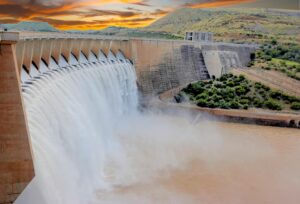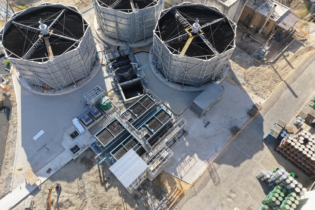The continuous rain throughout South Africa has boosted the country’s water levels, usually a good situation. However, over capacity dams pose flooding risks and the Vaal River system level is currently at 112% necessitating a controlled drainage to preserve the infrastructure and control flooding.
The Vaal Dam
The Vaal River system comprises several catchments and dams, one of which is the Vaal dam. The department of water and sanitation (DWS) has opened five key sluice gates with a discharge remains of 793 cubic metres per second (mᵌ/s) to manage the water levels at the dam. The inflow remains high at which 1248.11 mᵌ/s inflows from the upper catchment.Bloemhof dam
DWS has incrementally increased the water release at Bloemhof to 2200 mᵌ/s from 2000 mᵌ/s and will increase it further to 3000 mᵌ/s to manage the rising dam levels, currently sitting at 116%. These adjustments are necessary to manage the sustained high inflows and ensure safe operation of the dam. Bloemhof has 20 radial gates, five of which have been opened. Three of the gates are fully opened and two are partially opened at different metres.Impact
The current controlled water releases at both the dams may lead to overtopping of riverbanks downstream, and this will affect infrastructure built in lower-lying areas within the 1 in 100-year flood line.
DWS has issued an evacuation notice saying, “People living within the flood line of the Vaal River downstream of the Vaal Dam and the Bloemhof Dam should evacuate and move to a safe area, and remove valuable equipment, movable infrastructure and livestock.”The Integrated Vaal River System (IVRS) is experiencing extremely high inflows which dictates that dams within the system must be on high alert and implement the dam safety protocols based on the levels of water. The DWS continues to monitor inflow water levels in the IVRS to ensure that necessary precautions are in place in line dam safety standards and hydrological monitoring systems to safeguard infrastructure and attenuate flood conditions within the constraints of existing high dam levels. As part of the dam safety protocols, sluice gates are opened when dams breach the full capacity mark and overflow to prevent the infrastructure from failing which may lead to a dam bursting and causing a disaster of unimaginable magnitude. The Department is therefore implementing these necessary controlled water releases at the dams as part of dam safety precautions to safeguard the infrastructure and protect human life.









